Rice Pests and Diseases Around the World: Literature-Based Assessment with Emphasis on Africa and Asia
Abstract
:1. Introduction
2. Methods
2.1. Data Extraction
2.2. Data Curation Workflow
2.3. Data Analysis
3. Results
3.1. Databases Assessment on Rice Pests and Diseases
3.2. Geographical Distribution of the Records
3.3. Pests Affecting Rice Production
3.4. Diseases Affecting Rice Productivity
4. Discussion
4.1. Overall Assessment of Rice Pests
4.2. Overall Assessment of Rice Diseases
Top Diseases
4.3. Linking Diseases Agents as Major Constraints to Rice Productivity
4.4. Implications for Rice Production
5. Conclusions
Supplementary Materials
Author Contributions
Funding
Data Availability Statement
Conflicts of Interest
References
- Ewete, F.K.; Olagbaju, R.A. The development of Aspavia armigera Fabricius (Hemiptera: Pentatomidae) and its status as a pest of cowpea and rice. Int. J. Trop. Insect Sci. 1990, 11, 171–177. [Google Scholar] [CrossRef]
- Alves, T.M.; Maia, A.H.N.; Barrigossi, J.A.F. Spatial distribution and coexisting patterns of adults and nymphs of Tibraca limbativentris (Hemiptera: Pentatomidae) in paddy rice fields. Environ. Entomol. 2016, 45, 1505–1514. [Google Scholar] [CrossRef]
- Hereward, J.P.; Cai, X.; Matias, A.M.A.; Walter, G.H.; Xu, C.; Wang, Y. Migration dynamics of an important rice pest: The brown planthopper (Nilaparvata lugens) across Asia—Insights from population genomics. Evol. Appl. 2020, 13, 2449–2459. [Google Scholar] [CrossRef]
- Statista. Worldwide Production of Grain in 2023/24, by Type (in Million Metric Tons). Available online: https://www.statista.com/statistics/263977/world-grain-production-by-type/ (accessed on 13 July 2024).
- Heinrichs, E.A.; Muniappan, R. IPM for Tropical Crops: Rice. CAB Rev. 2017, 12, 1–31. [Google Scholar] [CrossRef]
- Bernaola, L.; Cosme, M.; Schneider, R.W.; Stout, M. Belowground inoculation with arbuscular mycorrhizal fungi increases local and systemic susceptibility of rice plants to different pest organisms. Front. Plant Sci. 2018, 9, 747. [Google Scholar] [CrossRef] [PubMed]
- Teeken, B.; Nuijten, E.; Temudo, M.P.; Okry, F.; Mokuwa, A.; Struik, P.C.; Richards, P. Maintaining or abandoning African rice: Lessons for understanding processes of seed innovation. Hum. Ecol. 2012, 40, 879–892. [Google Scholar] [CrossRef]
- Linares, O.F. African rice (Oryza glaberrima): History and future potential. Proc. Natl. Acad. Sci. USA 2002, 99, 16360–16365. [Google Scholar] [CrossRef]
- GRiSP. Rice Almanac: Source Book for One of the Most Economic Activities on Earth, 4th ed.; International Rice Research Institute: Los Baños, Philippines, 2013. [Google Scholar]
- van Andel, T. African rice (Oryza glaberrima Steud.): Lost crop of the enslaved Africans discovered in Suriname. Econ. Bot. 2010, 64, 1–10. [Google Scholar] [CrossRef] [PubMed]
- van Andel, T.R.; Meyer, R.S.; Aflitos, S.A.; Carney, J.A.; Veltman, M.A.; Copetti, D.; Flowers, J.M.; Havinga, R.M.; Maat, H.; Purugganan, M.D.; et al. Tracing ancestor rice of Suriname Maroons back to its African origin. Nat. Plants 2016, 2, 16149. [Google Scholar] [CrossRef]
- Bagirov, V.; Treshkin, S.; Korobka, A.; Dereka, F.; Garkusha, S.; Kovalev, V.; Esaulova, L.; Kizinek, S. Scientific support of the rice growing industry of the agroindustrial complex of the Russian Federation in solving the problems of food security. E3S Web Conf. 2020, 210, 05006. [Google Scholar] [CrossRef]
- Samal, P.; Babu, S.C.; Mondal, B.; Mishra, S.N. The global rice agriculture towards 2050: An inter-continental perspective. Outlook Agric. 2022, 51, 164–172. [Google Scholar] [CrossRef]
- Balasubramanian, V.; Sie, M.; Hijmans, R.J.; Otsuka, K. Increasing Rice Production in Sub-Saharan Africa: Challenges and Opportunities. Adv. Agron. 2007, 94, 55–133. [Google Scholar] [CrossRef]
- Agyen-Sampong, M. Mangrove swamp rice production in West Africa. In Dynamique et Usages de la Mangrove Dans les Pays des Rivières du Sud (du Sénégal à la Sierra Leone); Cormier-Salem, M.C., Ed.; ORSTOM Éditions: Paris, France, 1994; pp. 185–188. [Google Scholar]
- Adefurin, O.; Zwart, S.J. A Detailed Map of Rice Production Areas in Mangrove Ecosystems in West-Africa in 2013—Mapping of Mangrove Rice Systems Using Landsat 8 Satellite Imagery and Secondary Data; Technical Report; Africa Rice Center: Cotonou, Benin, 2017. [Google Scholar] [CrossRef]
- Pandey, S.; Byerlee, D.; Dawe, D.; Dobermann, A.; Mohanty, S.; Rozelle, S.; Hardy, B. Rice in the Global Economy: Strategic Research and Policy Issues for Food Security; International Rice Research Institute: Manila, Philippines, 2010. [Google Scholar]
- Mukherjee, A.K.; Bag, M.K.; Annamalai, M.; Adak, T.; Lenka, S.; Basana Gowda, G.; Prasanthi, G.; Raghu, S.; Baite, M.S.; Prabhukarthikeyan, S.R.; et al. Bio-intensive Management of Pest and Diseases of Rice. In Rice Research for Enhancing Productivity, Profitability and Climate Resilience; Pathak, H., Nayak, A.K., Jena, M., Singh, O.N., Samal, P., Sharma, S.G., Eds.; ICAR-National Rice Research Institute: Cuttack, India, 2018; pp. 404–418. [Google Scholar]
- Pathak, M.D.; Khan, Z.R. Insect Pests of Rice; IRRI: Manila, Philippines, 1994; p. 89. [Google Scholar]
- Wilson, B.E.; Villegas, J.M.; Stout, M.J.; Landry, K.J. Relative yield loss from stem borers (Lepidoptera: Crambidae) and rice water weevil (Coleoptera: Curculionidae) in rice. J. Econ. Entomol. 2021, 11, 1159–1165. [Google Scholar] [CrossRef]
- Sirvi, M.K.; Seervi, S.; Kumar, P. Pest management of yellow stem borer Scirpophaga incertulas in Rice. Just Agric. 2021, 1, 1–4. [Google Scholar]
- Mohapatra, S.D.; Raghu, S.; Prasanthi, G.; Baite, M.S.; Prabhukarthikeyan, S.R.; Yadav, M.K.; Basana Gowda, G.; Pandi, G.G.P.; Banerjee, A.; Aravindan, S.; et al. Bio-ecology of rice insect pests and diseases: Paving the way to climate-smart rice protection technologies. In Rice Research for Enhancing Productivity, Profitability and Climate Resilience; Pathak, H., Nayak, A.K., Jena, M., Singh, O.N., Samal, P., Sharma, S.G., Eds.; ICAR-National Rice Research Institute: Odisha, India, 2018; pp. 384–403. [Google Scholar]
- Morales, F.J.; Jennings, P.R. Rice hoja blanca: A complex plant-virus-vector pathosystem. CABI Rev. 2010, 5, 1–16. [Google Scholar] [CrossRef]
- Martin, J.E.; Jimenez, E.K.B.; Cruz, M.G.; Zhu-Salzman, K.; Way, M.O.; Badillo-Vargas, I.E. Assessing the potential infection of Tagosodes orizicolus (Hemiptera: Delphacidae) by Rice Hoja Blanca virus in Texas. J. Econ. Entomol. 2020, 113, 1018–1022. [Google Scholar] [CrossRef] [PubMed]
- Chen, B.; Chen, Y.; Chen, H.; Liang, Z.; Chen, J.; Wu, R.; Zhang, T.; Zhou, G.; Yang, X. Identification, characterization and prevalence in southern China of a new iflavirus in the leafhopper Recilia dorsalis (Hemiptera: Cicadellidae). Virus Res. 2023, 323, 199005. [Google Scholar] [CrossRef]
- Narayanasamy, P. Detection of Fungal Pathogens in Plants. In Microbial Plant Pathogens-Detection and Disease Diagnosis; Springer: Dordrecht, The Netherlands, 2011; Volume 1, pp. 5–199. [Google Scholar] [CrossRef]
- Miah, G.; Rafii, M.Y.; Ismail, M.R.; Sahebi, M.; Hashemi, F.S.G.; Yusuff, O.; Usman, M.G. Blast disease intimidation towards rice cultivation: A review of pathogen and strategies to control. J. Anim. Plant Sci. 2017, 27, 1058–1066. [Google Scholar]
- Kato, H. Rice blast disease. Pest. Outlook 2001, 12, 23–25. [Google Scholar] [CrossRef]
- Naqvi, S.A.H. Bacterial Leaf Blight of Rice: And overview of epidemiology and management with special reference to Indian sub-continent. Pak. J. Agric. Res. 2019, 32, 359. [Google Scholar] [CrossRef]
- Tennant, P.; Gubba, A.; Roye, M.; Fermin, G. Viruses as Pathogens: Plant Viruses. In Viruses; Tennant, P., Fermin, G., Foster, J.E., Eds.; Academic Press: Cambridge, MA, USA, 2018; Chapter 6; pp. 135–156. [Google Scholar] [CrossRef]
- Listihani, L.; Selangga, D.G.W.; Yuliadhi, K.A.; Yuniti, I.G.A.D.; Ariati, P.E.P. Molecular characterization of Rice ragged stunt virus and Rice grassy stunt virus on Rice in Gianyar, Bali, Indonesia. J. Trop. Plant Pest Dis. 2024, 24, 48–57. [Google Scholar] [CrossRef]
- Wang, P.; Liu, J.; Lyu, Y.; Huang, Z.; Zhang, X.; Sun, B.; Li, P.; Jing, X.; Li, H.; Zhang, C. A Review of Vector-Borne Rice Viruses. Viruses 2022, 14, 2258. [Google Scholar] [CrossRef] [PubMed]
- Bridge, J.; Plowright, A.; Peng, D. Nematode Parasites of Rice. In Plant Parasitic Nematodes in Subtropical and Tropical Agriculture, 2nd ed.; Luc, M., Sikora, R.A., Bridge, J., Eds.; CABI Publishing: Cambridge, MA, USA, 2005; pp. 87–130. [Google Scholar]
- Page, M.J.; McKenzie, J.E.; Bossuyt, P.M.; Boutron, I.; Hoffmann, T.C.; Mulrow, C.D.; Shamseer, L.; Tetzlaff, J.M.; Akl, E.A.; Brennan, S.E.; et al. The PRISMA 2020 statement: An updated guideline for reporting systematic reviews. BMJ 2021, 372, 71. [Google Scholar] [CrossRef]
- QGIS Development Team. QGIS Geographic Information System. Open Source Geospatial Foundation Project. Available online: http://qgis.osgeo.org (accessed on 12 July 2024).
- Gu, Z.; Gu, L.; Eils, R.; Schlesner, M.; Brors, B. Circlize implements and enhances circular visualization in R. Bioinformatics 2014, 30, 2811–2812. [Google Scholar] [CrossRef] [PubMed]
- R Core Team. R: A Language and Environment for Statistical Computing. R Foundation for Statistical Computing: Vienna, Austria. Available online: https://www.R-project.org/ (accessed on 12 July 2024).
- Mauri, M.; Elli, T.; Caviglia, G.; Uboldi, G.; Azzi, M. RAWGraphs: A Visualisation Platform to Create Open Outputs. In Proceedings of the 12th Biannual Conference on Italian SIGCHI Chapter, Cagliari, Italy, 18–20 September 2017. [Google Scholar] [CrossRef]
- Conde, S.; Catarino, S.; Monteiro, F. RAW Data. In Figshare 2024. Available online: https://figshare.com/articles/dataset/RAW_Data_PRISMA_/26332849 (accessed on 20 August 2024).
- FAOSTAT. Statistical Database. Food and Agriculture Organization of the United Nations, Rome. Available online: https://www.fao.org/faostat/en/#home (accessed on 28 June 2024).
- Muniyappa, V.; Ramakrishnan, K. Mycoplasma and allied pathogens of plants, animals and human beings. In Proceedings of the Workshop held at University of Agricultural Sciences, Bangalore, India, 14–16 February 1979. [Google Scholar]
- Alam, M.S. Whitefly (Hemiptera: Aleyrodidae): A potential pest of rice in West Africa. Int. Rice Res. Newsl. 1989, 14, 38–39. [Google Scholar]
- Fomba, S.N. Rice disease situation in mangrove and associated swamps in Sierra Leone. Trop. Pest Manag. 1984, 30, 73–81. [Google Scholar] [CrossRef]
- Awoderv, V.A.; Bangura, N.; John, V.T. Incidence, distribution and severity of bacterial diseases on rice in West Africa. Trop. Pest Manag. 1991, 37, 113–117. [Google Scholar] [CrossRef]
- Mau, Y.S.; Ndiwa, A.S.S.; Oematan, S.S. Brown spot disease severity, yield and yield loss relationships in pigmented upland rice cultivars from East Nusa Tenggara, Indonesia. Biodiversitas 2020, 21, 1625–1634. [Google Scholar] [CrossRef]
- Aluko, M.O. Crop losses caused by the brown leaf spot disease of rice in Nigeria. Agric. Food Sci. 1975, 59, 609–613. [Google Scholar]
- Ahmad, F.; Khan, M.R. Incidence of sheath blight in irrigated rice and associated yield losses in northern India. Plant Dis. 2023, 107, 2907–2915. [Google Scholar] [CrossRef]
- Issaka, S.; Basso, A.; Sorho, F.; Onasanya, A.; Haougui, A.; Sido, A.Y.; Aké, S.; Fargette, D.; Séré, Y. Diagnosis and importance of rice yellow mottle disease epidemics in Niger republic. J. Appl. Biosci. 2012, 50, 3501–3511. [Google Scholar]
- EPPO. EPPO Global Database. Available online: https://gd.eppo.int (accessed on 9 July 2024).
- Eniayejuni, A. Scientific research in West Africa and the impact of international collaboration: An analysis in Scopus database, 1997–2017. Afr. J. Libr. 2020, 30, 1–5. [Google Scholar]
- Olufadewa, I.I.; Adesina, M.A.; Ayorinde, T. From Africa to the world: Reimagining Africa’s research capacity and culture in the global knowledge economy. J. Glob. Health 2020, 10, 010321. [Google Scholar] [CrossRef] [PubMed]
- Chiasson, H.; Hill, S.B. Dormancy in the stalk-eyed fly, Diopsis longicornis MACQ, a pest of rice in Sub-Saharan Africa. Int. J. Trop. Insect Sci. 1995, 16, 303–310. [Google Scholar] [CrossRef]
- Akinsola, E.A.; Agyen-Sampong, M. The ecology, bionomics and control of rice stem-borers in West Africa. Int. J. Trop. Insect Sci. 1984, 5, 69–77. [Google Scholar] [CrossRef]
- Brenière, J. The importance of entomological problems in the development of rice-growing in West Africa. Agron. Trop. 1969, 24, 906–927, (In French with English Abstract). [Google Scholar]
- Feijen, H.R.; Feijen, C. Diopsis mayae sp. N. (Diptera, Diopsidae), a dominant stalk-eyed fly, occurring from South Africa to Saudi Arabia. Tijdschrift Voor Entomol. 2017, 160, 61–74. [Google Scholar] [CrossRef]
- Ba, N.M.; Dakouo, D.; Nacro, S.; Karamage, F. Seasonal abundance of lepidopteran stemborers and diopsid flies in irrigated fields of cultivated (Oryza sativa) and wild rice (Oryza longistaminata) in western Burkina Faso. Int. J. Trop. Insect Sci. 2008, 28, 30–36. [Google Scholar] [CrossRef]
- Khan, Z.R.; Litsinger, J.A.; Barrion, A.T.; Villanueva, F.F.D.; Fernandez, N.J.; Taylo, L.D. World Bibliography of Rice Stem Borers, 1794–1990; International Rice Research Institute: Manila, Philippines, 1991. [Google Scholar]
- De Prins, J.; De Prins, W. Afromoths, Online Database of Afrotropical Moth Species (Lepidoptera). World Wide Web Electronic Publication. Available online: http://www.afromoths.net (accessed on 10 July 2024).
- Umeh, E.D.N.; Joshi, R.C.; Ukwungwu, M.N. Biology, status and management of rice insect pests in Nigeria. Crop Prot. 1992, 11, 408–413. [Google Scholar] [CrossRef]
- Roland, B.; Bernard, G.C.; Elie, D.A.; Séraphin, Z.A. Diopsis (Diopsis thoracica and D. apicalis) damaging rice production in Africa: A review. Int. J. Curr. Res. Biosci. Plant Biol. 2017, 4, 33–41. [Google Scholar] [CrossRef]
- Bragard, C.; Baptista, P.; Chatzivassiliou, E.; Di Serio, F.; Gonthier, P.; Jaques Miret, J.A.; Justesen, A.F.; Magnusson, C.S.; Milonas, P.; Navas-Cortes, J.A.; et al. Pest categorisation of Nilaparvata lugens. EFSA J. 2023, 21, 7999. [Google Scholar] [CrossRef]
- Chen, Y.H.; Romena, A. Feeding Patterns of Scirpophaga incertulas (Lepidoptera: Crambidae) on Wild and Cultivated Rice During the Booting Stage. Environ. Entomol. 2006, 35, 1094–1102. [Google Scholar]
- Ali, M.P.; Bari, M.N.; Haque, S.S.; Kabir, M.M.M.; Nowrin, F.; Choudhury, T.R.; Mankin, R.W.; Ahmed, N. Response of a rice insect pest, Scirpophaga incertulas (Lepidoptera: Pyralidae) in warmer world. BMC Zool. 2020, 5, 6. [Google Scholar] [CrossRef]
- Jiang, M.X.; Cheng, J.A. Interactions between the striped stem borer Chilo suppressalis (Walk.) (Lep., Pyralidae) larvae and rice plants in response to nitrogen fertilization. J. Pest Sci. 2003, 76, 124–128. [Google Scholar] [CrossRef]
- Liu, Y.; Yi, J.; Jia, H.; Miao, Y.; Hou, M. Sogatella furcifera saliva mucin-like protein is required for feeding and induces rice defences. Int. J. Mol. Sci. 2022, 23, 8239. [Google Scholar] [CrossRef]
- Zhou, C.; Yang, H.; Wang, Z.; Long, G.Y.; Jin, D.C. Comparative transcriptome analysis of Sogatella furcifera (Horváth) exposed to different insecticides. Sci. Rep. 2018, 8, 8773. [Google Scholar] [CrossRef] [PubMed]
- Baladhiya, H.C.; Sisodiya, D.B.; Pathan, N.P. A review on pink stem borer, Sesamia inferens Walker: A threat to cereals. J. Entomol. Zool. Stud. 2018, 6, 1235–1239. [Google Scholar]
- Kouassi, N.K.; N’Guessan, P.; Albar, L.; Fauquet, C.M.; Brugidou, C. Distribution and characterization of Rice yellow mottle virus: A threat to African farmers. Plant Dis. 2005, 89, 124–133. [Google Scholar] [CrossRef]
- Rajamani, K.; Chintagunta, L.; Raj, G.B. Climate Change Impact on Pests and Disease Intensity of Rice. Theor. Biol. Forum 2022, 11, 80–83. [Google Scholar] [CrossRef]
- Shakeel, Q.; Mubeen, M.; Sohail, M.A.; Ali, S.; Iftikhar, Y.; Tahir Bajwa, R.; Aqueel, M.A.; Upadhyay, S.K.; Divvela, P.K.; Zhou, L. An explanation of the mystifying bakanae disease narrative for tomorrow’s rice. Front. Microbiol. 2023, 14, 1153437. [Google Scholar] [CrossRef]
- Bashyal, B.M. Etiology of an emerging disease: Bakanae of rice. Indian Phytopathol. 2018, 71, 485–494. [Google Scholar] [CrossRef]
- Wang, G.C.; Chen, H.K.; Xu, P.S.; Bao, J.Y. Studies on the pathogens of the rice bakanae disease in Zhejiang. Acta Phytop. Sin. 1990, 20, 93–97, (In Chinese with English abstract). [Google Scholar]
- Bashyal, B.M.; Aggarwal, R. Molecular identification of Fusarium species associated with bakanae disease of rice (Oryza sativa) in India. Indian J. Agric. Sci. 2013, 83, 71–76. [Google Scholar]
- Zainudin, N.A.I.M.; Razak, A.A.; Salleh, B. Bakanae disease of rice in Malaysia and Indonesia: Etiology of the causal agent based on morphological, physiological and pathogenicity characteristics. J. Plant Prot. Res. 2008, 48, 475–485. [Google Scholar] [CrossRef]
- Zainudin, N.A.I.M.; Sidique, S.N.M.; Salleh, B. Genetic Diversity of Fusarium fujikuroi Isolated from Bakanae Disease of Rice on the Basis of Vegetative Compatibility. Pertanika J. Trop. Agric. Sci. 2008, 31, 271–278. [Google Scholar]
- Reddy, K.R.N.; Reddy, C.S.; Abbas, H.K.; Abel, C.A.; Muralidharan, K. Mycotoxigenic fungi, mycotoxins, and management of rice grains. Toxin Ver. 2008, 27, 287–317. [Google Scholar] [CrossRef]
- El-Shanshoury, A.E.-R.R.; El-Sabbagh, S.M.; Emara, H.A.; Saba, H.E. Occurrence of moulds, toxicogenic capability of Aspergillus flavus and levels of aflatoxins in maize, wheat, rice and peanut from markets in central delta provinces, Egypt. Int. J. Curr. Microbiol. Appl. Sci. 2014, 3, 852–865. [Google Scholar]
- Dong, F.; Xing, Y.J.; Lee, Y.W.; Mokoena, M.P.; Olaniran, A.O.; Xu, J.H.; Shi, J.R. Occurrence of Fusarium mycotoxins and toxigenic Fusarium species in freshly harvested rice in Jiangsu, China. World Mycotoxin J. 2020, 13, 201–212. [Google Scholar] [CrossRef]
- Xiang, Z.; Okada, D.; Asuke, S.; Nakayashiki, H.; Ikeda, K. Novel insights into host specificity of Pyricularia oryzae and Pyricularia grisea in the infection of gramineous plant roots. Mol. Plant Pathol. 2022, 23, 1658–1670. [Google Scholar] [CrossRef]
- Suzuki, H. Studies on the relations between the anatomical characters of the rice plant and its susceptibility to blast disease. J. Coll. Agric. 1937, 24, 181–264, (In Japanese with English Abstract). [Google Scholar]
- Muimba-Kankolongo, A. Cereal Production. In Food Crop Production by Smallholder Farmers in Southern Africa; Muimba-Kankolongo, A., Ed.; Academic Press: Ottawa, Canada, 2018; pp. 73–121. [Google Scholar] [CrossRef]
- Bakker, W. Rice yellow mottle, a mechanically transmissible virus disease of rice in Kenya. Neth. J. Plant Pathol. 1970, 76, 53–63. [Google Scholar] [CrossRef]
- Ochola, D.; Issaka, S.; Rakotomalala, M.; Pinel-Galzi, A.; Ndikumana, I.; Hubert, J.; Hébrard, E.; Séré, Y.; Tusiime, G.; Fargette, D. Emergence of rice yellow mottle virus in eastern Uganda: Recent and singular interplay between strains in East Africa and in Madagascar. Virus Res. 2015, 195, 64–72. [Google Scholar] [CrossRef] [PubMed]
- Luk’yanchikov, V.P.; Sorokina, Z.A. Virus disease of rice. Zash. Rast. 1979, 12, 35–36, (In Russian with English Abstract). [Google Scholar]
- Azzam, O.; Chancellor, T.C.B. The biology, epidemiology, and management of rice tungro disease in Asia. Plant Dis. 2002, 86, 88–100. [Google Scholar] [CrossRef] [PubMed]
- Banerjee, A.; Roy, S.; Tarafdar, J.; Senapat, B.K. Present status of rice tungro disease in West Bengal: Occurrence and characterization of viruses. J. Crop Weed 2009, 5, 229–232. [Google Scholar]
- Bunawan, H.; Dusik, L.; Bunawan, S.N.; Amin, N.M. Rice Tungro disease: From identification to disease control. World Appl. Sci. J. 2014, 31, 1221–1226. [Google Scholar]
- John, V.T. Identification and characterization of tungro, a virus disease of Rice in India. Plant Dis. Rep. 1968, 52, 871–875. [Google Scholar]
- Rivera, C.T.; Ou, S.H.; Tantere, D.M. Tungro disease of rice in Indonesia. Plant Dis. Rep. 1968, 52, 122–124. [Google Scholar]
- Huang, S.; Wang, L.; Liu, L.; Tang, S.; Zhu, D.; Savary, S. Rice spikelet rot disease in China—1. Characterization of fungi associated with the disease. Crop Prot. 2011, 30, 1–9. [Google Scholar] [CrossRef]
- Hu, S.; Yu, J.; Wei, K.; Lan, B.; Li, M.; Xie, B.; Zhu, Y.; Yang, Y.; Zhu, J.; Zhang, L.; et al. Studies on the biological characteristics and pathogenic identification of rice spikelet rot disease in Jiangxi province. Acta Agric. Univ. Jiangxiensis 2019, 41, 234–242. [Google Scholar]
- Cerda, R.; Avelino, J.; Gary, C.; Tixier, P.; Lechevallier, E.; Allinne, C. Primary and secondary yield losses caused by pests and diseases: Assessment and modeling in coffee. PLoS ONE 2017, 12, e0169133. [Google Scholar] [CrossRef]
- Ambikadevi, D. White backed plant hopper, Sogatella furcifera (Horvath) (Homoptera: Delphacidae) a major pest of rice in Kuttanad, Kerala. Insect Environ. 1998, 4, 36. [Google Scholar]
- Saha, M.; Chakraborty, A.; Bhattacharya, K. Aerobiology, epidemiology and disease forecasting of false smut disease of rice in West Bengal, India. Aerobiologia 2020, 36, 299–304. [Google Scholar] [CrossRef]
- FAO. Irrigation Potential in Africa: A Basin Approach; FAO: Rome, Italy, 1997; p. 117. Available online: https://openknowledge.fao.org/handle/20.500.14283/w4347e (accessed on 26 June 2024).
- Al-Gamal, S.A.; Sokona, Y.; Dodo, A.K. Climatic changes and groundwater resources in Africa. Int. J. Clim. Chang. Strateg. Manag. 2009, 1, 133–145. [Google Scholar] [CrossRef]
- Pinel, A.; N’Guessan, P.; Bousalem, M.; Fargette, D. Molecular variability of geographically distinct isolates of Rice yellow mottle virus in Africa. Arch. Virol. 2000, 145, 1621–1638. [Google Scholar] [CrossRef]
- Tollenaere, C.; Lacombe, S.; Wonni, I.; Barro, M.; Ndougonna, C.; Gnacko, F.; Sérémé, D.; Jacobs, J.M.; Hebrard, E.; Cunnac, S.; et al. Virus-bacteria rice co-infection in Africa: Field estimation, reciprocal effects, molecular mechanisms, and evolutionary implications. Front. Plant Sci. 2017, 8, 645. [Google Scholar] [CrossRef]
- Bertrand, G.N.; Fatogoma, S.; Brahima, K. Development of rice yellow mottle disease depending on topographic positions of the lowland in Côte d’Ivore. Plant Pathol. J. 2018, 17, 87–94. [Google Scholar] [CrossRef]
- Miah, G.; Rafii, M.Y.; Ismail, M.R.; Puteh, A.B.; Rahim, H.A.; Asfaliza, R.; Latif, M.A. Blast resistance in rice: A review of conventional breeding to molecular approaches. Mol. Biol. Rep. 2012, 40, 2369–2388. [Google Scholar] [CrossRef]
- Chukwu, S.; Rafii, M.; Ramlee, S.; Ismail, S.; Hasan, M.; Oladosu, Y.; Magaji, U.G.; Akos, I.; Olalekan, K.K. Bacterial leaf blight resistance in rice: A review of conventional breeding to molecular approach. Mol. Biol. Rep. 2019, 46, 1519–1532. [Google Scholar] [CrossRef]
- Karan, R.; Kalaimathi, D.; Renganathan, P.; Balabaskar, P. Isolation and characterization of phylloplane associated bacteria and its in vitro antagonistic activity against Bipolaris oryzae. Agric. Sci. Dig. 2022, 1–4. [Google Scholar] [CrossRef]
- Agbowuro, G.; Afolabi, M.; Olamiriki, E.; Awoyemi, S. Rice blast disease (Magnaporthe oryzae): A menace to rice production and humanity. Int. J. Pathog. Res. 2020, 4, 32–39. [Google Scholar] [CrossRef]
- Khatun, M.; Nessa, B.; Salam, M.; Kabir, M. Strategy for rice disease management in bangladesh. Bangladesh Rice J. 2021, 25, 23–36. [Google Scholar] [CrossRef]
- Kim, Y.; Roh, J.; Kim, H. Early forecasting of rice blast disease using long short-term memory recurrent neural networks. Sustainability 2017, 10, 34. [Google Scholar] [CrossRef]
- Wraight, S.P. Synergism between insect pathogens and entomophagous insects, and its potential to enhance biological control efficacy. In Predators and Parasitoids; Koul, O., Dhaliwal, G.S., Eds.; Taylor & Francis: London, UK; New York, NY, USA, 2003; p. 146. [Google Scholar]
- Sparks, A.; Castilla, N.P.; Cruz, C.M.V. Sheath Root. Rice Knowledge Bank. IRRI. Available online: http://www.knowledgebank.irri.org/training/fact-sheets/pest-management/diseases/item/sheath-rot (accessed on 14 March 2025).
- Xiuzhen, F. Rice-Fish Culture in China. Aquac. Asia 2003, 8, 44–46. [Google Scholar]
- Keleman, P.-J.; Durand, J.-D.; Simier, M.; Camará, A.; Sá, R.M.; Panfili, J. eDNA-based seasonal monitoring reveals fish diversity patterns in mangrove habitats of Guinea-Bissau, West Africa. Reg. Stud. Mar. Sci. 2025, 82, 104013. [Google Scholar] [CrossRef]
- Huang, S.; Wang, L.; Liu, L.; Fu, Q.; Zhu, D. Nonchemical pest control in China rice: A review. Agron. Sustain. Dev. 2014, 34, 275–291. [Google Scholar] [CrossRef]
- Conde, S.; Barai, A.; Catarino, S.; Costa, G.J.; Ferreira, S.; Tavares, I.; Ferreira, M.R.; Temudo, M.P.; Monteiro, F. Hidden secrets of mangrove swamp rice stored seeds in Guinea-Bissau: Assessment of fungal communities and implications for food security. Agronomy 2024, 14, 1870. [Google Scholar] [CrossRef]
- Conde, S.; Monteiro, F.; Catarino, S.; Ferreira, M.R.; Ferreira, S. Uninvited guests: New stored mangrove rice insect pests in Guinea-Bissau. J. Stored Prod. Res. 2025, 111, 102567. [Google Scholar] [CrossRef]
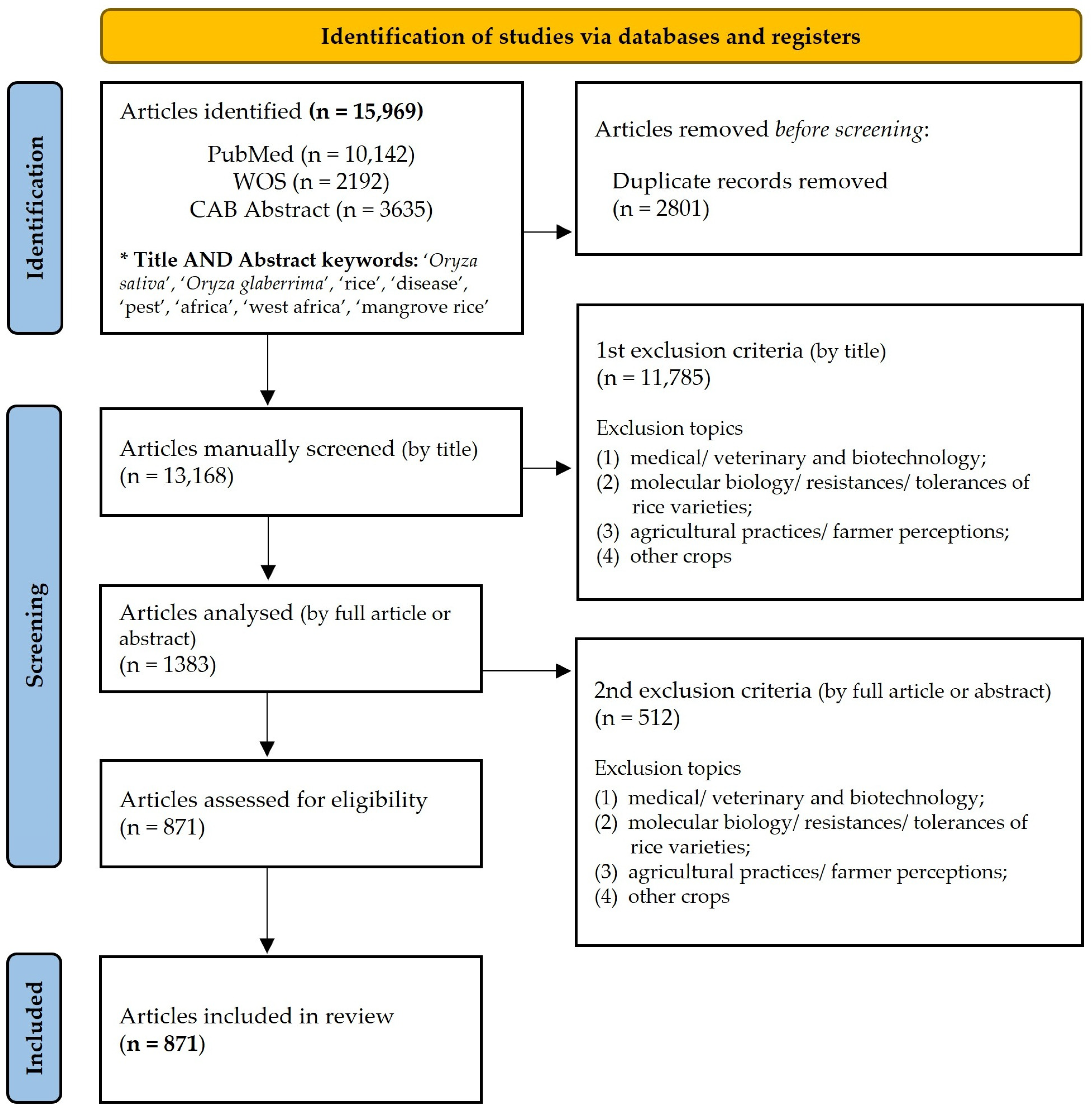
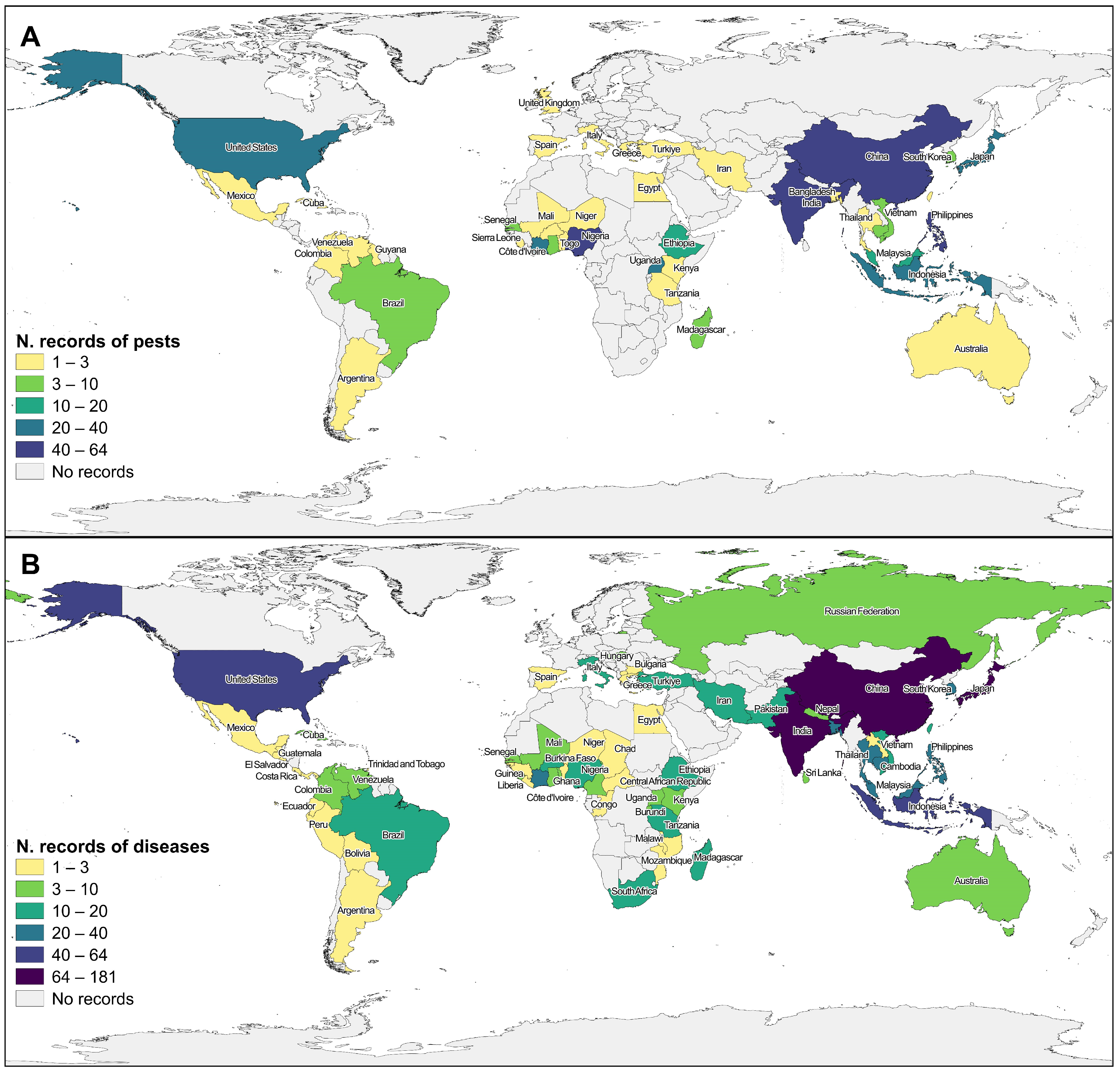
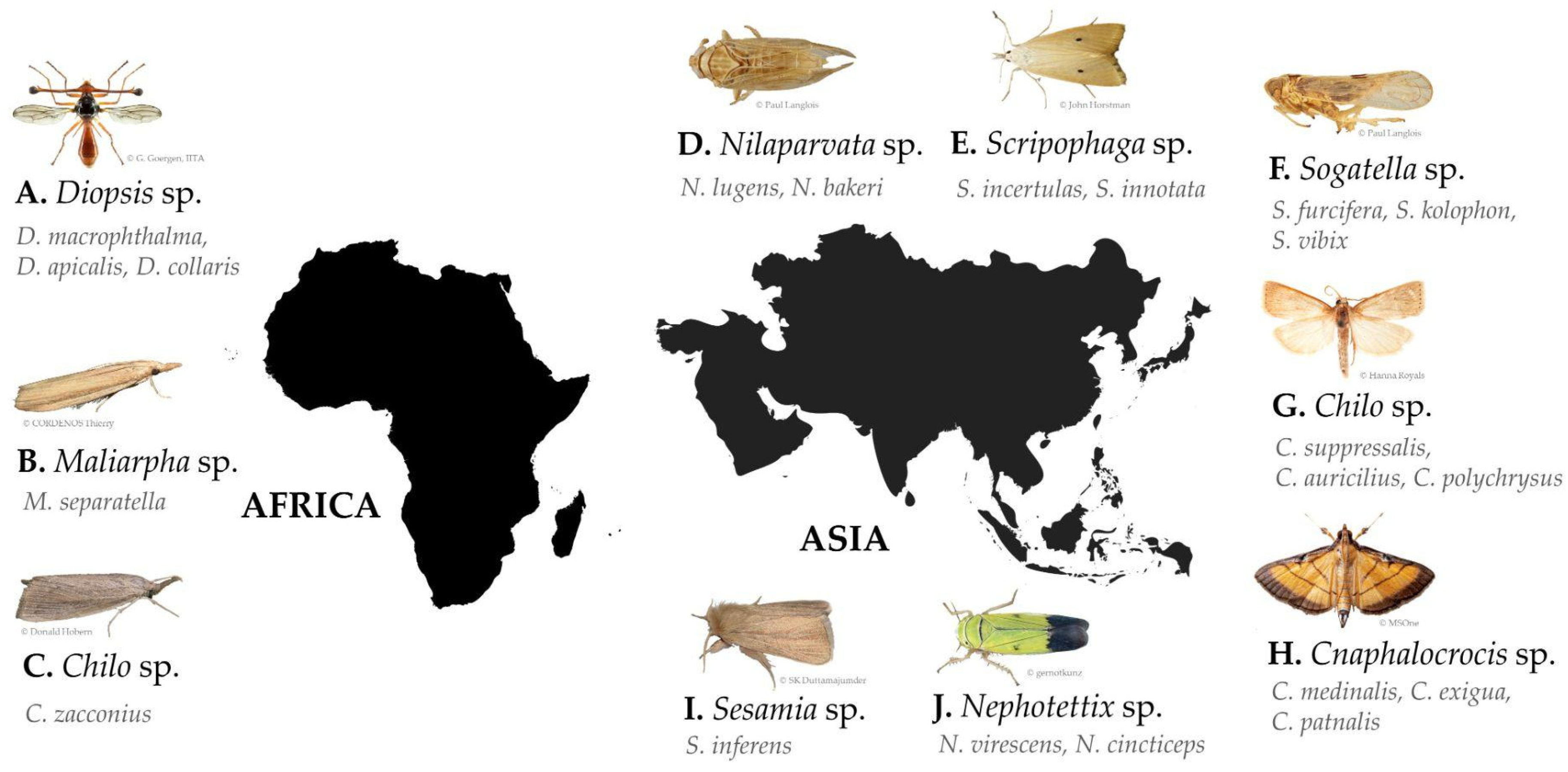
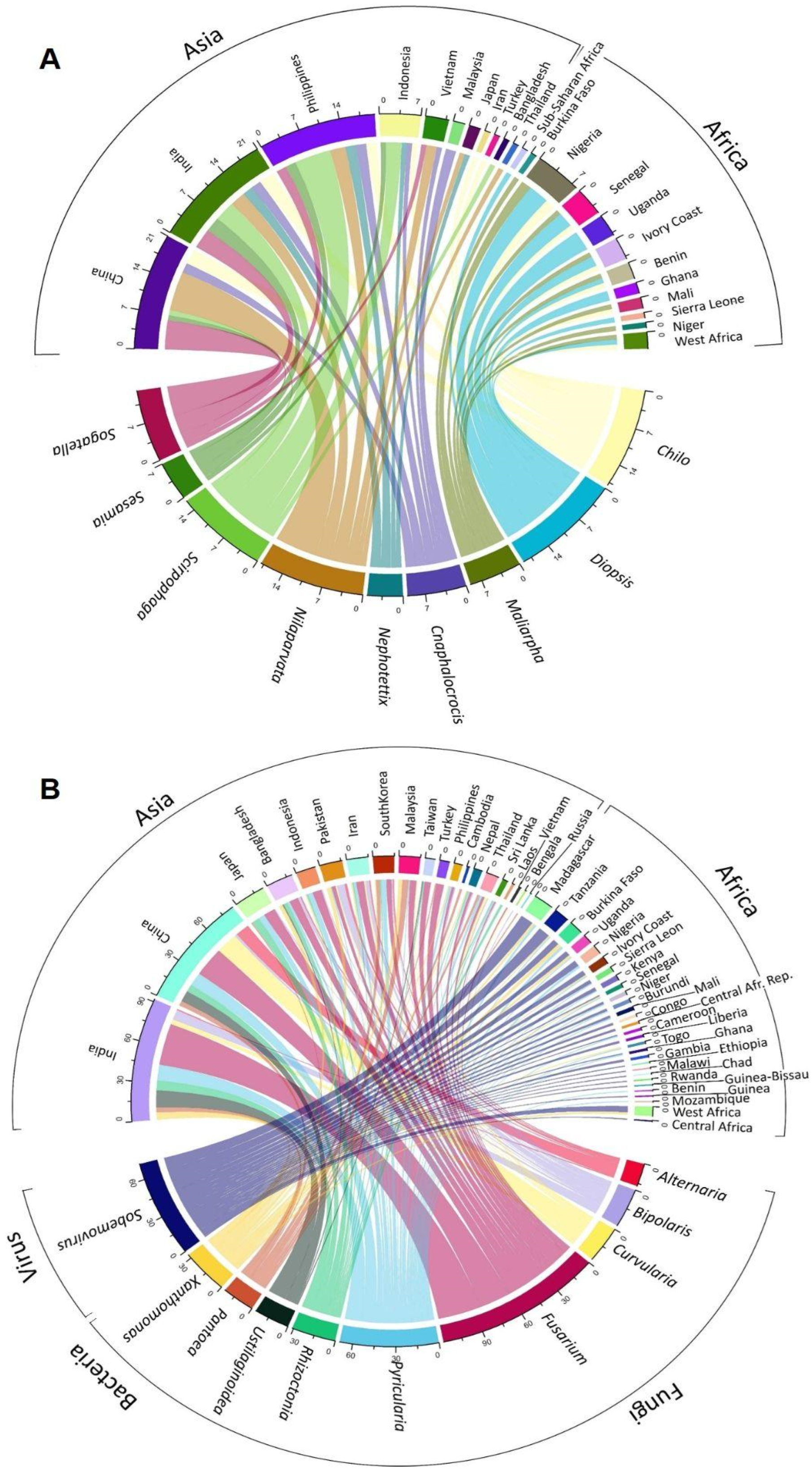
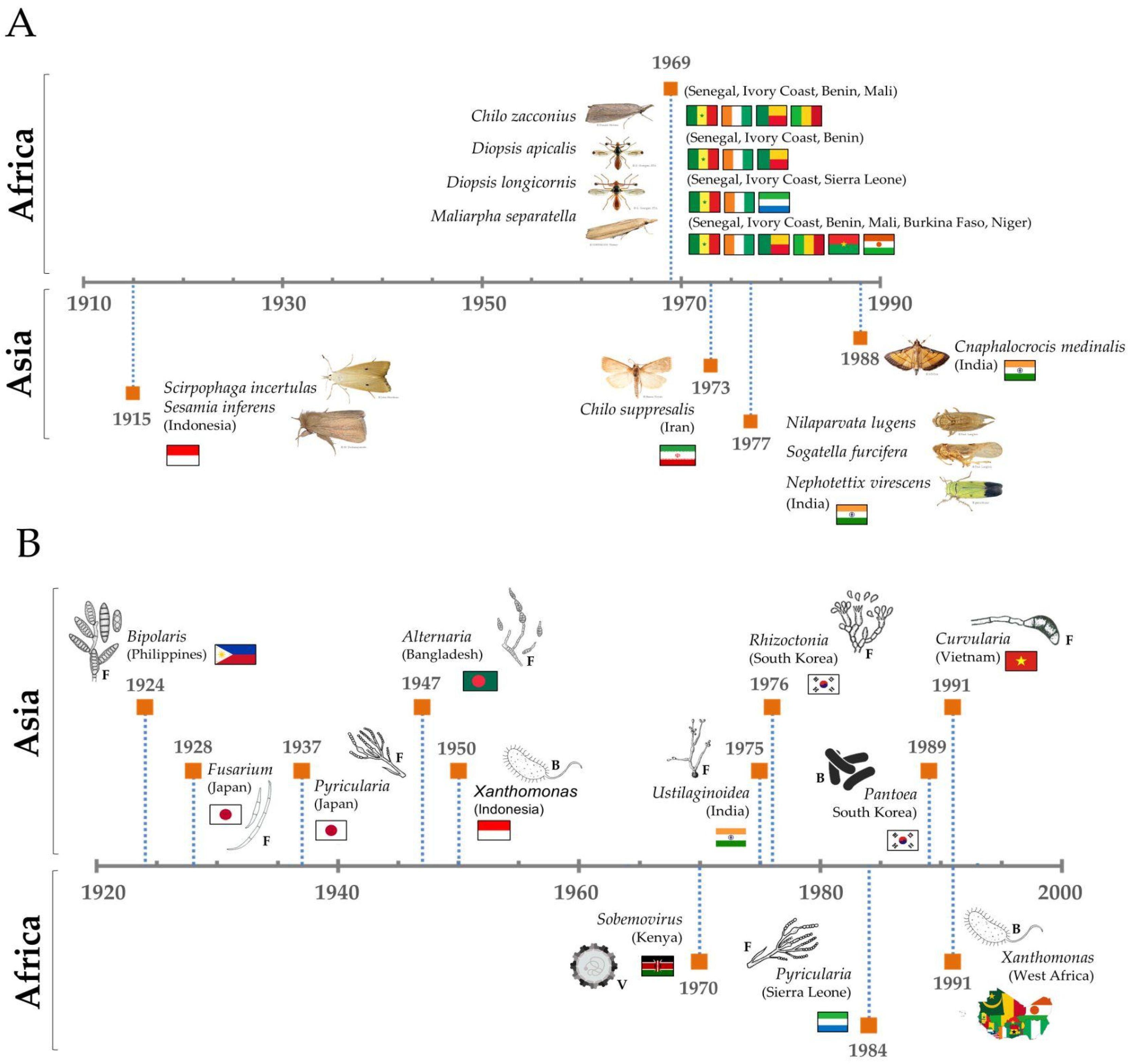

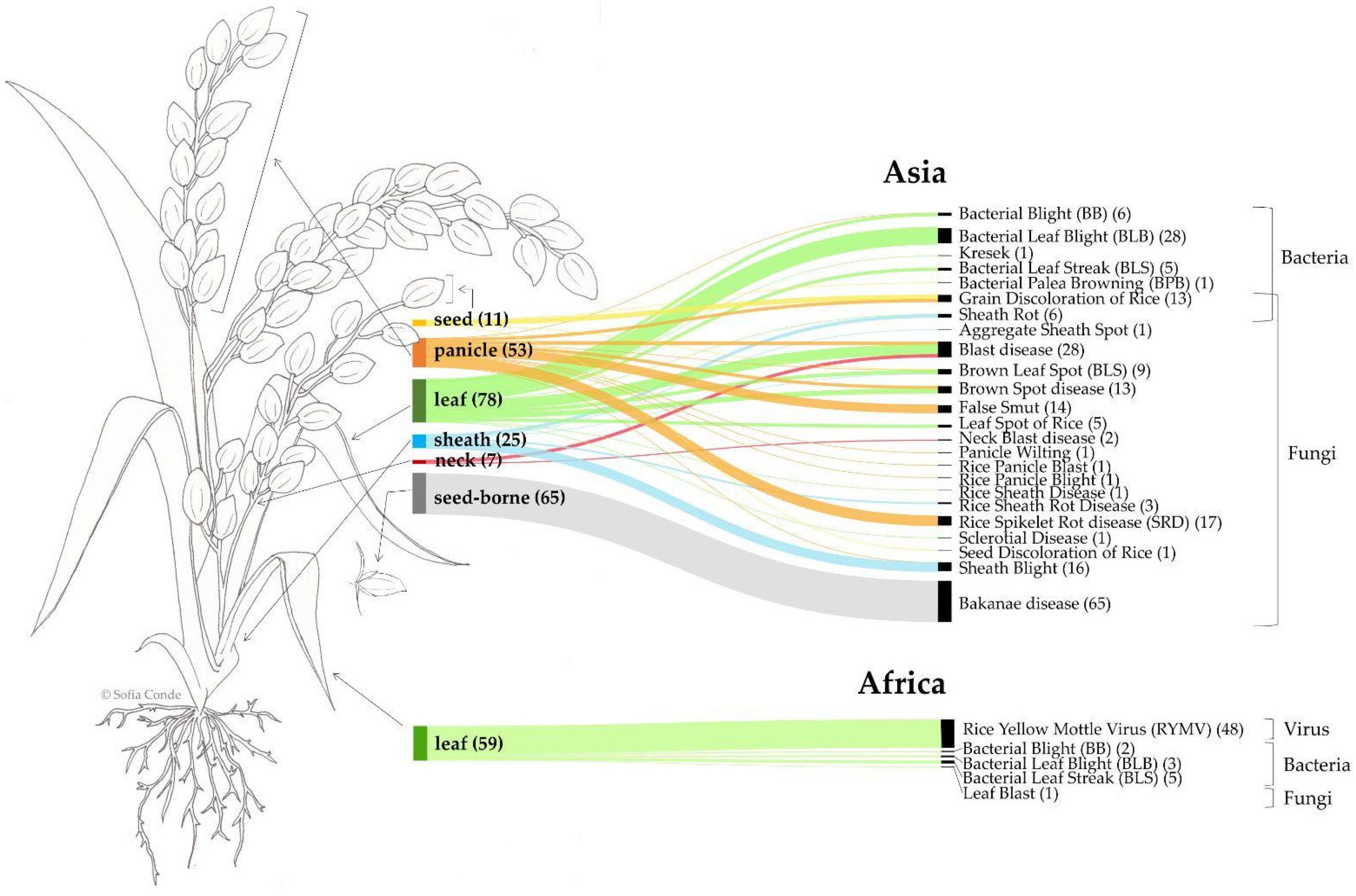
Disclaimer/Publisher’s Note: The statements, opinions and data contained in all publications are solely those of the individual author(s) and contributor(s) and not of MDPI and/or the editor(s). MDPI and/or the editor(s) disclaim responsibility for any injury to people or property resulting from any ideas, methods, instructions or products referred to in the content. |
© 2025 by the authors. Licensee MDPI, Basel, Switzerland. This article is an open access article distributed under the terms and conditions of the Creative Commons Attribution (CC BY) license (https://creativecommons.org/licenses/by/4.0/).
Share and Cite
Conde, S.; Catarino, S.; Ferreira, S.; Temudo, M.P.; Monteiro, F. Rice Pests and Diseases Around the World: Literature-Based Assessment with Emphasis on Africa and Asia. Agriculture 2025, 15, 667. https://doi.org/10.3390/agriculture15070667
Conde S, Catarino S, Ferreira S, Temudo MP, Monteiro F. Rice Pests and Diseases Around the World: Literature-Based Assessment with Emphasis on Africa and Asia. Agriculture. 2025; 15(7):667. https://doi.org/10.3390/agriculture15070667
Chicago/Turabian StyleConde, Sofia, Sílvia Catarino, Sónia Ferreira, Marina Padrão Temudo, and Filipa Monteiro. 2025. "Rice Pests and Diseases Around the World: Literature-Based Assessment with Emphasis on Africa and Asia" Agriculture 15, no. 7: 667. https://doi.org/10.3390/agriculture15070667
APA StyleConde, S., Catarino, S., Ferreira, S., Temudo, M. P., & Monteiro, F. (2025). Rice Pests and Diseases Around the World: Literature-Based Assessment with Emphasis on Africa and Asia. Agriculture, 15(7), 667. https://doi.org/10.3390/agriculture15070667






